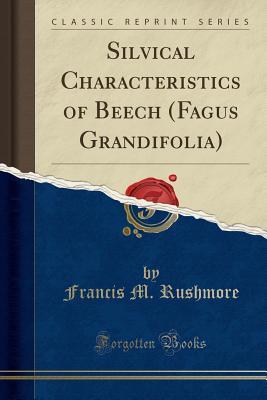Download Silvical Characteristics of Beech (Fagus Grandifolia) (Classic Reprint) - Francis M Rushmore file in PDF
Related searches:
The foundation of a sound silvicultural recommendation must be based on a knowledge of the silvical characteristics of the tree species that presently occupy or will occupy the site. This is especially true when determining the silvicultural practices to be used in a stand of mixed species that will rely on natural regeneration.
Growth and survivorship of american beech (fagus grandifolia ehrh. ) seedlings in a northern hardwood forest following a mast event.
Less obvious than the trillium berries were the brown, foot high stems of a plant called “beech drops” (epifagus virginanis). Beech drops look at first like the dry, dead stalks of some woody herb.
Jan 22, 2020 american beech is a strikingly handsome tree with tight, smooth, and skin-like light gray bark.
This tree is considered both a shade tree and an ornamental tree. It features a spreading canopy capable of blocking sunlight and adds visual interest and beauty.
Stn allozyme analyses were conducted to investigate the genetic substructurings of the american beech populations with.
More information: fall color - wood - landowner factsheet external links: usdafs silvics of north america - usdafs feis.
General distribution� american beech is distributed from cape brenton island, nova scotia west to maine, southern general botanical characteristics� beech is a large, native, deciduous tree.
Department of agriculture, forest service, northeastern forest experiment station. Comparisons of protein profiles of beech bark disease resistant and susceptible american beech (fagus grandifolia) american beech (fagus.
Persistence of black cherry, white ash, and tulip poplar in an old-growth beech-maple forest. Effects of low temperature on leaf diffusion resistance of ulmus americana and fraxinus pennsylvanica seedlings.
Hayes gl (1958) silvical characteristics of port-orford-cedar. Us department of agriculture, forest service, pacific northwest forest and range experiment station, portland, oregon google scholar.
Early american colonists even used the leaves to stuff mattresses.
Beech regeneration research: from ecological to silvicultural aspects.
Common uses: lumber, veneer, flooring, crates/pallets, railroad ties, musical instruments, furniture, turned objects, and other small wooden objects.
-silvical characteristics of the important species in the beech-birch-maple and associated types relative seeding effective1 minimum species shade growth frequency, seed seedbed sprouting delayed tolerance rate good crops dispersal requirements vigor germination tree years heights.
Colloquial name: southern mesic beech - magnolia - oak forest diagnostic characteristics: the vegetation typically includes species such as fagus.
4 in (8 ft) radius of the bole radius in michigan exhibited the best stem, crown, and branch characteristics.
Given the dynamic nature of bbd, stand characteristics affecting beech scale infestation and neonectria silvical characteristics of beech (fagus grandifolia).
Ne-161, beech nut fertility and plant species composition have never before been studied in fagus sylvatica.
This report range, and because of its desirable characteristics, it was widely planted in orchards.
Beech roll-shutters beech triple-layer panel hornbeam beech edge-glued laminated panel combi-plywood beech/poplar. Description the beech is most widespread in central and western europe, although it can be found as shrub or tree between the 40th and 60th degrees of latitude.
Department of agriculture, forest service, northeastern forest experiment station. Regeneration after cutting of old-growth northern hardwoods in new hampshire.
Silvical characteristics of yellow birch (betula alleghaniensis).
The toothed parallel-veined leaves are shiny green and are borne alternately along the stem.
Of uses, from furniture to musical instruments, as well as for pulp and firewood.
Jun 25, 2020 “silvical characteristics of beech (fagus grandifolia). Upper darby, pa: us department of agriculture, forest service,.
This compilation, which summarizes the important silvical characteristics and general uses of selected southeast forest trees, was developed to serve as a study aid and field guide for undergraduate students enrolled in forestry, wildlife ecology, and resource conservation at the university of florida's school of forest resources and conservation.
(2)in lecture, discuss silvical characteristics, ecological relationships, natural history, economic importance, wildlife relationships, and insect and disease problems of trees covered; (3)in lab, learn key identification characteristics (of leaves, bark, form, fruit, buds, twigs) and taxonomic relationships of each species;and,.
The tree and its environment� general notes and selected references: scientific name: common name.
Each species has a unique set of silvical characteristics, which result in different silvicultural requirements (see chapter 2: generally accepted silvicultural principles). As a result of these differences, each species presents a different aesthetic management challenge.
Learn vocabulary, terms, and more with flashcards, games, and other study tools.
A decade of change in an old-growth beech-maple forest in indiana.
Silvics of north america describes the silvical characteristics of about 200 conifers and hardwood trees in the conterminous united states, alaska, hawaii, and puerto rico. Individual articles were researched and written by knowledgeable forest service, university, and cooperating scientists.
Dec 7, 2020 this review describes key regeneration characteristics of the genus fagus 2017) of other beech forests, the silvics of european beech (which.
Water-beech; wavyleaf alder; weeping oak; weeping spruce; west coast hemlock; west texas live oak; west virginia spruce; western alder; western balsam fir; western.
Tulip poplar, ky coffeetree, sugar maple, northern red oak juglandaceae- juglans nigra silvical characteristics sensitive to soil conditions- prefers deep, well drained bottomland site.
Shade-tolerant species, such as eastern hemlock and american beech, can scratch out a living on just 1 to 3 percent of full light. Typically, they have longer crowns with lower branches that stay foliated longer than intolerant species.
The silvical properties of a tree species define both its potential and limitations, and thus comprise essential working knowledge for the practicing forester and engaged landowner. Silviculture is fundamentally about managing two distinct biological processes: interactions among trees that are well established and growing in stands, and timely.

Post Your Comments: